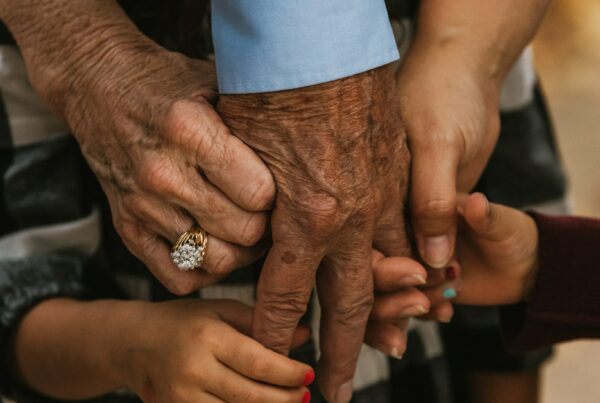This CJ blog series “Rooted: Elders, Ancestors, and Collective Memory” continues with an entry from our Masterclass faculty Dr. Yolanda Pierce.
There is a haunting photo of Danella Bryant taken during the civil rights movement. An African American seventeen-year-old and Parker High School senior, Danella was among the many children and teens who were active in the movement in Alabama. During a demonstration outside the Traffic Engineering Building in Birmingham on May 5, 1963, a news photographer captured her praying. In the photograph she is kneeling on the concrete and grass, her hands clasped as tears stream down her face. Although they are outside the frame of this particular picture, other photos from that day show the water hoses and police dogs and armed law enforcement officials waiting to break up the demonstration—an unarmed group of children.
The picture evokes powerful emotions. Perhaps it’s her youthfulness or the gloves in her hands or the look of pain in her eyes. And while kneel-ins and prayer vigils were a regular feature of the civil rights movement, this image of a singular, young Black teenager’s body in prayer is particularly striking. The viewer is prompted to wonder what she is praying for at this particular moment. Is it a prayer for her safety and that of others? Is it a plea to end the violence being brutally inflicted upon nonviolent Black bodies? Is it a petition to simply make it home safely to her parents? And does God ultimately hear and answer her prayer?
This evocative image illustrates all the ways that prayer in the African American context is both deeply personal and highly communal. Danella Bryant is kneeling and crying; it is a scene of her own personal anguish. But just outside the frame of her own moment of prayer is an entire community of other Black teens and children—some also praying, some protesting, some shield- ing others from violence. Her prayer is not a moment of inaction. It is an active calling on the divine presence in the middle of a literal battle. …
Prayer is a contradiction. One may feel profoundly alone in the moment of prayer, but when you enter before the throne of grace, the divine is present. And while the kneeling position—body bent, hands folded—may seem like a posture of submission, prayer itself can be a battle.
To be present in worship is to bring our full selves into the process. Worship involves our minds being open and receptive to the wisdom of the Word. Yes, worship means being open to the explication and theology of the scholar, but also being open to the common sense of the great cloud of witnesses who have walked before us. Yes, it means our minds being open to the theological nuances of our faith, but also ever leaning on the Everlasting Arms.
As a womanist theologian, I affirm that worship involves our physical bodies being fully present: the lifting of the hands, the tapping of the feet, the standing in affirmation, the shaking of the head, and even the running around the sanctuary. Worship is the joyful acknowledgment that this broken vessel of a body is yet wonderfully and fearfully made in the image of God. When we are fully present in worship, we focus our attention on the One who has made us, the One who sustains us.
When we are fully present in mind and soul and body, we embrace worship as a time of praise and thanksgiving as well as a time of lament and mourning. When we are fully present in worship, we participate in a creative theological process, daring to both raise and answer questions about the nature and reality of God. Theological work cannot simply take place in academic spaces; it is not a dry set of questions to be posed by those who are “qualified,” those who have a set of particular educational credentials. You do theology in community, and the best theology reflects the cares and concerns of that community. This theology often shows up in sermons, songs, and praises.
Content taken from In My Grandmothers House by Dr. Yolanda Pierce, ©2020. Used by permission of Broadleaf Publishing.

Dr. Yolanda Pierce is Professor and Dean of the Howard University School of Divinity. She is a scholar of African American religious history, womanist theology, race and religion, and an alumna of Princeton University and Cornell University. Pierce served as the founding director of the Center for the Study of African American Religious Life at the Smithsonian National Museum of African American History & Culture. A widely published author, Pierce’s newest book, In My Grandmother’s House: Black Women, Faith, and the Stories We Inherit, was released in February 2021. She is a native New Yorker, mentor, public theologian, community activist, cable news commentator, member of Alpha Kappa Alpha Sorority, Inc., and ordained minister. Follow her on Twitter, her digital home: @YNPierce.
This entry is part of our blog series “Rooted: Elders, Ancestors, and Collective Memory”. As BIPOC communities, our faith has been deeply formed by the experiences of our people. Our communities have developed ways of knowing and understanding God through suffering, lament, joy, and hope. Our stories, narratives, and faith practices developed over generations are rooted in context, cultural values, and the struggle for justice. Let’s learn from one another and develop a collective memory that leads to a prophetic imagination.
The views and opinions expressed on the Chasing Justice Blog are those of the authors and do not necessarily reflect the official policy or position of Chasing Justice. Any content provided by our bloggers or authors are of their opinion and are not intended to malign any religion, ethnic group, club, organization, company, individual or anyone or anything.







